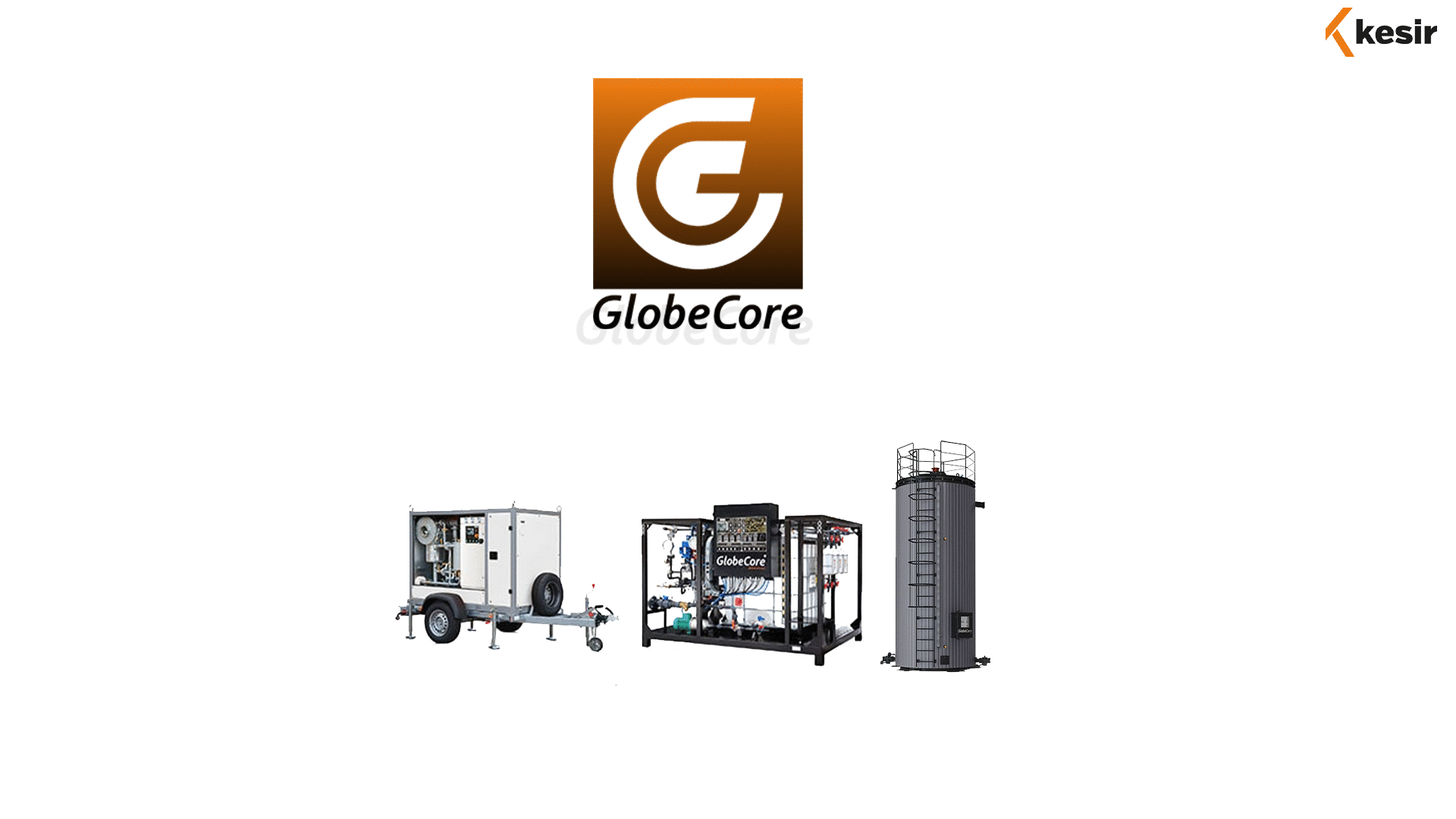
GlobeCore
KESİR bünyesinde GlobeCore ürünlerinin Türkiye distribütörlüğünü yapmaktadır. Merkez Ofisi Almanya'da bulunan GlobeCore, endüstriyel üretimde dünya liderlerinden biridir.
GlobeCore ürünleri;
- bitüm emülsiyonlarının üretiminde,
- trafo yağı rejenerasyonunda, saflaştırmasında,
- yakıt harmanlamasında,
- biyodizel üretiminde ve
- hemen hemen her malzemenin emülsiyonlaştırılmasında kullanılmaktadır.
Üretim tesisi, uluslararası endüstri standartlarına uygun olarak donatılmıştır: robotik plazma metal kesiciler, otomatik kaynak sistemleri ve modern PLC kontrollü makinelere sahiptir.
GlobeCore teknolojilerinin avantajları nelerdir?
Her şeyden önce çevre dostu bir ekipmandır. Atmosfere zararlı kirlilikler yaymaz ve çevreyi atık yağların bertarafından veya depolanmasından kurtarır.
İkinci avantaj finansaldır. Düzenli yağ işlemi, yağ dolu ekipmanın servis ömrünü ve güvenilirliğini uzatır. Ayrıca, yağ satın alma ve bertaraf etme, bakım ve onarım maliyetlerinin yanı sıra zorunlu arıza süresinin neden olduğu maliyetlerden de tasarruf sağlar.
Üçüncü avantaj, yağ arıtma tesislerinin bakımı ve işletilmesinin kolaylığı ve güvenliğidir.
Müşterinin rahatı için, bu ekipman hareketli (bir römork üzerinde, tekerlekler üzerinde) veya sabittir. Özel koşullarda (patlamaya dayanıklı) çalışmak üzere tasarlanmıştır.
GlobeCore teknolojileri ile yağ işlemenin başlıca avantajları:
- Tüm güvenlik standartlarına uygun olarak trafoya bağlantı (Trafo Güvenlik Sistemi);
- Köpük önleyici sistem;
- Yağ sensörleri;
- Değiştirilebilir kartuşlar (filtrasyon inceliği 1, 5 ve 25 mikron);
- Düşük ısı kapasitesine sahip güvenli ve kolay ayarlanabilen bantlı ısıtıcılar;
- Vakum kolonunda verimli pıhtılaştırıcı-buharlaştırıcı;
- Tam otomatik süreç
Yağ Arıtma
Atık yağlar küresel çevremiz için bir sorundur. Kara ve su kütlelerinin geniş alanlarını kirleterek hayvanların ölümüne ve insanlarda ciddi hastalıklara neden olurlar. En etkili çözüm, yağın saflaştırılması ve ardından saflaştırılmış yağların yeniden kullanılmasıdır.
Genellikle yağ arıtma, çökeltme, santrifüjleme, pıhtılaşma, seçici saflaştırma, filtrasyon ve bu yöntemlerden bazılarının birleştirilmesinden oluşan rejenerasyondan oluşan çok aşamalı bir işlemdir.
Sedimantasyon, yerçekimi kuvvetleri kullanarak yağı özel kaplarda temizler. Sonuç olarak, katıların yanı sıra serbest ve çözünmüş suyu da giderir. Santrifüjleme bu safsızlıkları giderir ve daha az zaman aldığı için daha etkilidir. Elektrofiziksel yağ arıtma, katı kirleticileri ve kısmen yağ çamurunu ve eskiyen ürünleri giderir. Bazen yağ arıtmasında pıhtılaştırma kullanılır. Ancak gerçekte, diğer yaklaşımları yalnızca özel maddeler (pıhtılaştırıcılar) yağa katarak ve bu da safsızlıkların birleşmesini teşvik ederek yoğunlaştırır. Daha sonra daha büyük parçacıkların filtrasyon, çökeltme veya santrifüjleme yoluyla çıkarılması daha kolaydır.
Seçici saflaştırma, istenmeyen yağ bileşenlerinin çözücüler yardımıyla seçici olarak çözülmesidir. Yağdaki yabancı maddeleri çıkardıktan sonra çözücüler çıkarılır ve yeniden kullanılır. Bu yaklaşımın ana dezavantajı, katkı maddeleri içeren yağların işlenememesidir. Yağ katkı maddeleri, zararlı bileşenlerle birlikte bir çözücü tarafından emildiğinden, performansın bozulmasına neden olur.
Yağ filtrasyonu
Üst yazıda bahsedildiği gibi, yağ filtrasyonu esas olarak mekanik safsızlıkları, emülsifiye edilmiş ve çözünmüş suyu gideren filtre preslerinin yardımıyla gerçekleştirilir. Filtre presi, yağı, suyu ve katı parçacıkları tutan gözenekli ortamdan iter. Mevcut kirleticilerin miktarına ve doğasına göre bir filtre ortamı seçilir.
Filtrelemeyi etkileyen faktörler şunlardır:
- Yağın viskozitesi;
- Filtre ortamı kalınlığı;
- Filtre ortamı yüzey alanı;
- Yağ basıncı.
Transformatör yağı filtrasyonu, esas olarak gözenekli polimer filtrelerin yardımıyla gerçekleştirilmektedir. Yağ kirliliklerini tutarlar ve partikül konsantrasyonlarını ve partikül sayısını kontrol ederek kirlilikleri boyut ve gruplara göre dağıtırlar.
Genellikle yağ filtrasyonu, yağı katı parçacıkları yakalayan bir filtre bölümünden geçirmek için basınç pompalar kullanır. Manyetik filtreler farklı çalışır. Ferromanyetik malzemelerin parçacıklarını çekerler.
Filtreler gerekli inceliği sağlar. Kaba, orta ve ince yağ filtrasyonu. Ayrıca, bazı filtreler değiştirilebilir ve bazılarında çıkarılabilir bir filtre elemanı bulunur.
Yağı Gazdan Arındırma
Servis yağı su ve çözünmüş gazlar içermemelidir. Gaz kabarcıkları genellikle elektrik boşalmaları içerdiğinden, çözünmüş gazlar yalıtım sisteminin genel elektrik gücünü azaltır. Bu nedenle, güç transformatörlerinin ve diğer endüstriyel ekipmanların çalıştırılmasında yağdan gazının alınması gerekli bir önlemdir.
Günümüzde yağın termal vakum işlemi ile gazdan arındırılması en etkili çözümdür. Güç transformatörlerinin üreticileri, güvenilir çalışma için saha kurulumu ve rutin bakım sırasında yağ gazının alınmasını talep eder. İyi kullanım için trafo yağı, hacimce %0,1'den fazla gaz içermemelidir.
Yağ Rejenerasyonu
Çalışma sırasında yağ, yalnızca katı parçacıklar, su ve gazlarla değil, aynı zamanda performans özelliklerini önemli ölçüde azaltan yaşlanma ve oksidasyon ürünleriyle de kirlenebilir. Bu kirlilik, yağ parametrelerini iyileştiren ve yağın ve tüm transformatörün hizmet ömrünü 20-25 yıldan fazla uzatan rejenerasyon yoluyla giderilir.
Genellikle "yağ rejenerasyonu" ve "yağ arıtma" terimleri tanımlanır. Ama aslında bunlar aynı süreçler değildir. Yağ arıtma, yağ rejenerasyonunun bir parçasıdır. Ancak, genellikle yağ yaşlanması henüz kritik bir seviyeye ulaşmadığında bağımsız olarak da kullanılır.
Rejenerasyon ayrıca çamuru, asitleri, asfalt reçineli maddeleri, organometalik ve poliaromatik bileşikleri, doymamış hidrokarbonları ve bozunma ürünlerini de giderir. İşlem özel katkı maddeleri ile stabilize edilir.
Pratik operasyonda, asit sayısı analiz edilerek yağın eskime derecesi belirlenir. Asit sayısı değeri aşağıdaki yağ özelliklerini belirler:
- Asit sayısı 0.25 mg KOH / g'nin altında olan yağlar;
- Yüksek derecede yaşlanmaya sahip yağlar (asit sayısı 0.25-0.5 mg KOH / g);
- Ağır oksitlenmiş yağlar (asit sayısı 0,5 mg KOH / g'yi aşıyor).
Yukarıda listelenen yağ arıtma yöntemleri, oksidasyon ve yaşlanma ürünlerini ortadan kaldıramaz. Bu nedenle yağ, asit bileşiklerini, asfalt reçineli maddeleri ve çalışma sırasında oluşan diğer ürünleri tutan adsorbanlar yardımıyla yeniden üretilir. Bu yaklaşım nispeten basittir ve yüksek bir saflaştırma oranına sahiptir.
GlobeCore Sistemi
GlobeCore, CMM yağ temizleyicileri üretir. Bu ekipman, yağ ürünlerinin saflaştırılması ve yenilenmesi için piyasanın en son trendleri ve gereksinimleri dikkate alınarak tasarlanmıştır.
Modern yağ geri kazanım teknolojilerini kullanır:
- Katı parçacıkların uzaklaştırılması için çok aşamalı filtrasyon;
- Su ve gazların uzaklaştırılması için termal vakum işlemi;
- Oksidasyon ve yaşlanma ürünlerini (silis jel, zeolit, Fuller toprağı) uzaklaştırmak için adsorban saflaştırma.
Yağın durumuna bağlı olarak hem yağ arıtıcı hem de yağ rejenerasyon tesisi seçebilirsiniz. GlobeCore'un en iyi ekipmanlarından biri, yalıtım yağlarını doğrudan enerjili bir transformatörün tankında işlemek için tasarlanmış bir CMM-R ünitesi olarak kabul edilir. Adsorban reaktivasyonu ile bir dizi proses, ısıtma, gazdan arındırma, vakum işlemi ve adsorban saflaştırma yoluyla yağı yeniler. Ünite, yağ arıtma için Fuller'ın toprağını kullanır.
Yağ arıtıcı CMM-P, enerjili ve enerjisiz transformatöre bağlanabilir. Yağ, transformatör ve yağ arıtma cihazı arasında kapalı bir döngüde dolaşırken yeniden üretilir. Fullers toprak adsorbanı, bir tankta biriken yaşlanan ürünleri ve tortuları giderir.
GlobeCore teknolojisinin bir diğer önemli avantajı, adsorbanın tekrar tekrar etkinleştirilmesidir. Fuller'ın toprak özellikleri, 2-3 yıllık CMM-R çalışmasına eşdeğer olan 300 kata kadar geri yüklenebilir.
Doğru seçilmiş rejenerasyon düzenliliği, güç transformatörlerinin hizmet ömrünü uzatır, dielektrik güçlerini ve elektriksel yalıtkan yağların kimyasal bileşimini eski haline getirir.
Daha detaylı bilgi için tıklayınız
